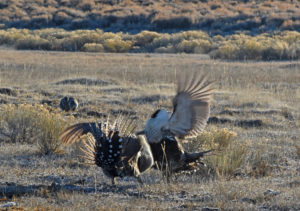WWP has been involved in oversight of grazing and public lands management in Oregon for many years, including through its successful litigation challenging grazing in the Louse Canyon Geographic Management Area in southeast Oregon to protect sage-grouse habitat, and on the Malheur National Forest, where livestock degrade the habitat of endangered steelhead trout. More recently, WWP has fought to protect threatened bull trout and Oregon spotted frogs, as well as endangered Lost River and shortnose suckers, from grazing on the Fremont-Winema National Forest.
Much of the Oregon landscape is shrub steppe and livestock grazing is the predominant use of public lands east of the Cascades. The BLM manages over 13 million acres of arid public lands in the state, including 92 Areas of Critical Environmental Concern (ACECs), 85 wilderness study areas, and many miles of wild and scenic rivers. These BLM lands include more than 10 million acres of habitat for Greater sage-grouse. In 2015, the BLM closed 15 Research Natural Areas to livestock grazing to protect sage-grouse habitat and provide ungrazed reference areas. Unfortunately, the Trump administration, under pressure from the livestock grazing industry, has proposed to reverse those closures.
A multitude of other special-status species are also found on Oregon public lands: Interior redband trout; Columbia spotted frog; pygmy rabbit; Kit fox; Yellow-billed Cuckoo; Grasshopper sparrow; and bighorn sheep to name only a handful.
Wolves are also making a comeback in Oregon. A number of packs are established in the northeast portion of the state, and wolves are also recolonizing the Cascades. Although poaching has claimed several wolves in the southern Cascades, wolves continue to find their way to southern Oregon and disperse into California. In 2018, the White River wolves—Oregon’s first northern Cascades wolf pack—had pups. Unfortunately, Oregon’s wolf management plan allows agencies to kill wolves when they eat livestock that have been turned out into their territories on public land.
There are many valuable wildlife areas in Oregon. Some of the best-known include the Malheur and Klamath Basin National Wildlife Refuges, Steens Mountain Cooperative Management and Protection Area, and Hart Mountain National Antelope Refuge. Livestock production has a number of harmful impacts to native wildlife and public lands in Oregon. In several areas, however, including in the Steens, Hart Mountain, and Cascade-Siskiyou National Monument, grazing privileges have been retired, and these areas provide inspiring examples of how landscapes can recover after livestock are permanently removed.
Mining on public lands and waterways also threatens Oregon wildlife, including bull trout, salmon, steelhead, and greater sage-grouse.
WWP advocates for the responsible management and protection of native species and their habitat in Oregon through participation in administrative processes, and litigation when necessary. WWP members and staff also monitor important field locations, including on the Vale, Lakeview, and Burns BLM Districts, and on the Fremont-Winema National Forest, in addition to many areas in Idaho, Nevada, and California contiguous to Oregon public lands.
Please feel free to contact the Oregon offices if you have any questions or want to get involved.
Adam Bronstein, Oregon Director
P.O. Box 1855
Sisters OR 97759
tel: (541) 595-8034
fax: (208) 475-4702
adam@westernwatersheds.org






